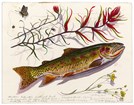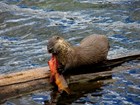In this edition of Yellowstone Science, we describe the significant progress that has already been made, along with the challenges that lie ahead as we continue our efforts to conserve native fish. As most of what occurs with fish lies under the surface of the water and largely out of sight, we hope that these articles will be revealing, enlightening, and increase understanding of the management approaches taken as we promote the restoration and preservation of native fish.
-
Yellowstone National Park
Article 1: Native Trout on the Rise

The waters of Yellowstone National Park are among the most pristine on Earth. Here at the headwaters of the Missouri and Snake rivers, the park’s incredibly productive streams and lakes support an abundance of fish. Following the last glacial period 8,000-10,000 years ago, 12 species/subspecies of fish recolonized the park. These fish, including the iconic cutthroat trout, adapted and evolved to become specialists in the Yellowstone environment... Read more
-
Yellowstone National Park
Article 2: An Approach to Conservation of Native Fish in Yellowstone

In the late 1800s, the waters of Yellowstone National Park (YNP) supported an abundance of fish. Twelve species (or subspecies) of native fish, including Arctic grayling, mountain whitefish, and cutthroat trout, dispersed to this region about 8,000-10,000 years ago following glacier melt. These native fish species provided food for both wildlife and human inhabitants. At the time YNP was established in 1872, park inhabitants and visitors initially harvested fish... Read more
-
Yellowstone National Park
Article 3: Status & Conservation of Yellowstone Cutthroat Trout in the GYE

Yellowstone cutthroat trout are native to the Greater Yellowstone Ecosystem (GYE) and surrounding drainages, including the Yellowstone River, Snake River, and Two Ocean Pass that facilitate connectivity between these drainages... Read more
-
Yellowstone National Park
Article 4: Westslope Cutthroat Trout & Fluvial Arctic Grayling Restoration

The Madison and Gallatin rivers, two major headwaters of the Missouri River, originate in Yellowstone National Park (YNP) along the western boundary (figure 1). Combined, these two rivers provide 1,031 km (640 mi.) of stream habitat for both westslope cutthroat trout and Arctic grayling in YNP. Indigenous westslope cutthroat trout currently occupy 2 km (1.2 mi.) of stream within their historic range in the park, while resident grayling were extirpated from the park by 1935... Read more
-
Yellowstone National Park
Article 5: Effects of Rotenone on Amphibians and Macroinvertebrates in Yellowstone

NPS Photo - J. Fleming Read more
-
Yellowstone National Park
Article 6: Preservation of Native Cutthroat Trout in Northern Yellowstone

The northern portion of Yellowstone National Park (YNP) is a valuable stronghold for native fish; it presents many opportunities to protect and restore them where they have been impacted by human activities. More than 3,700 km (2,299 mi.) of streams drain into the Yellowstone River and flow north into Montana (figure 1). The Lamar River drainage alone contains over 1,792 km (1,113 mi.) of streams and accounts for almost 20% of the stream distance in YNP ... Read more
-
Yellowstone National Park
Article 7: Non-native Lake Trout Induce Cascading Changes in the Yellowstone Lake

The mountainous region within and bordering southeastern Yellowstone National Park (YNP) is among the most remote in the contiguous United States. Lying completely within wilderness, the watershed of the upper Yellowstone River is pristine. Snowmelt waters feed numerous tributaries to the Yellowstone River, which ultimately winds northward to Yellowstone Lake. The Yellowstone River contributes one-third of the flow to Yellowstone Lake within a watershed that encompasses... Read more
-
Yellowstone National Park
Article 8: Suppressing Non-native Lake Trout to Restore Native Cutthroat Trout in Yellowstone Lake

The suppression of lake trout via netting has been ongoing in Yellowstone Lake since 1994 when this non-native species was first discovered. Twenty-two years later, we continue to catch large numbers of lake trout. So, why should lake trout suppression be maintained, what’s the science behind it, and what’s the prognosis for the future?... Read more
-
Yellowstone National Park
Article 9: Fish Population Responses to the Suppression of Non-native Lake Trout

Unprecedented actions are being taken on Yellowstone Lake to suppress lake trout, recover native cutthroat trout, and restore the natural character of the ecosystem. To understand the outcomes of these actions, long-term monitoring of the fish populations is conducted to inform an adaptive management strategy. Multiple lines of evidence are used to assess status and trends... Read more
-
Article 10: Identifying Movement Patterns and Spawning Areas of Lake Trout in Yellowstone Lake

The National Park Service has been attempting to suppress non-native lake trout in Yellowstone Lake since 1995, primarily using gillnets (Koel et al. 2005). By October 2016, approximately 2.3 million lake trout had been removed. Increased gillnetting effort accelerated the number of lake trout removed per summer, from approximately 70,000 in 2007 to approximately 366,000 in 2016... Read more
-
Yellowstone National Park
Article 11: Lake trout–induced spatial variation in the benthic invertebrates of Yellowstone Lake

Invasive lake trout indirectly increased biomass and body mass of amphipods. Read more
-
Yellowstone National Park
Article 12: Protecting the Greater Yellowstone Ecosystem from Aquatic Invasive Species
Perhaps no greater threat exists to public recreation, infrastructure, and aquatic resources in the Greater Yellowstone Ecosystem (GYE) than that from aquatic invasive species (AIS). AIS are aquatic animals, plants, and pathogens that can negatively impact ecosystems, industry, tourism, and even human health when they become established in waters outside of their historic range... Read more
-
Article 13: Yellowstone Trout Facts

Did you know that trout spend 80% of their day foraging for food? Learn more about these fascinating creatures. Read more
-
Yellowstone National Park
Article 14: Women in Science: Fisheries
Yellowstone National Park presents a unique opportunity for young professionals pursuing a career in fisheries management and research. Every year seasonal fisheries technicians, Student Conservation Association (SCA) interns, and volunteers from all over the world are hired to join the fisheries team. Many who start as technicians or interns here go on to pursue graduate education and careers in the fisheries profession... Read more
-
Yellowstone National Park
Article 15: YS 25-1-Shorts
Shorts are articles that summarize the results of recent scientific publications or highlight human interest stories occurring in the GYE. In this issue they discuss Fly Fishing Volunteers, an editorial by Nate Schweber, and birds and mammals that eat cutthroat trout in Yellowstone Lake and its tributaries. Read more
-
Yellowstone National Park
Article 16: A Day in the Field: Of Mice and Hantivirus

Yellowstone’s northern range, undoubtedly one of the prime wildlife viewing spots in North America, harbors impressive bison herds, wolf packs, and meandering bears. Visitors are likely to depart from the park’s northern lands with at least one, if not more, checks on their wildlife card. Beneath the awe of the large herds and charismatic megafauna lives a quiet, hidden life... Read more
-
Article 17: News and Notes YS-25-1
Dr. Fred Allendorf, professor emeritus at the University of Montana and member of the University’s Fish and Wildlife Genomics Group, has won the 2015 Molecular Ecology prize. This international award, bestowed annually by the journal Molecular Ecology, recognizes scientists for their significant contributions in this interdisciplinary field of research... Read more
-
Yellowstone National Park
Article 18: Sneak Peek: 60 Years of Archeology in Yellowstone
Wild, pristine, untrammeled. When thinking about Yellowstone, a vast and amazing backcountry, large carnivores, ungulates, iconic geysers, and geothermal features fill the imagination. However, 11,000 years of Yellowstone’s human history is for most people a hidden text. As we approach sixty years of archeological research in the park, we know a great deal more about how ancestors of today’s Native American tribes lived in Yellowstone... Read more




